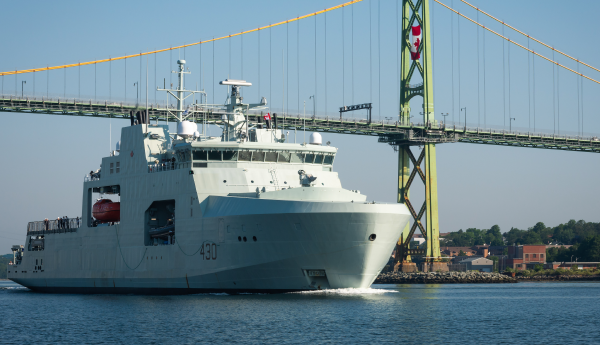When Kevin Lafleur stepped into his current role, he brought years of experience in naval procurement and sustainment. His journey began as a co-op student at Carleton University in Ottawa, Ontario, eventually leading him through various roles at National Defence (DND), and to where he is today: a Senior Director for the Marine Sustainment Directorate at Public Services and Procurement Canada (PSPC). This is where he leads a dedicated team that plays a crucial role in ensuring the operational readiness of Canada’s naval fleet. It’s a mission that lies at the heart of the National Shipbuilding Strategy (NSS), which is celebrating its 15th anniversary this year.

Repair, refit and maintenance projects
The NSS consists of 3 pillars:
- construction of large vessels
- construction of small vessels
- vessel repair, refit and maintenance projects
“We firmly represent the third pillar of the NSS,” Lafleur explains. “We work closely, in a collaborative environment, with our clients in DND‘s Maritime Equipment Program Management Division to respond to the needs of the Royal Canadian Navy (RCN) and ensure that the ships are able to fulfill their operational requirements.”
Under the third pillar, Lafleur’s team manages numerous maintenance and in-service support contracts with the RCN, including 2 major sustainment programs: the arctic offshore and patrol ships (AOPS) and replenishment ships (JSS). The team also manages 3 contracts for Halifax-class ships. “The third pillar is about more than just fixing ships; it’s about ensuring that Canada’s naval vessels, whether brand new or decades old, are always ready to serve,” says Lafleur. This includes everything from maintenance and engineering to managing supplies.
By the end of summer 2025, 6 AOPS will have been maintained under this framework. His Majesty’s Canadian Ship (HMCS) Harry DeWolf will be the first ship of its class to complete a docking work period in 2025. These work periods typically involve bringing the vessel out of the water, inspecting and repairing, if necessary, the hull, and other underwater components, as well as upgrading or overhauling onboard systems and addressing wear and tear from operational use. The Harry DeWolf-class ships will each undergo a docking work period every 5 years
Furthermore, the team is preparing for the arrival of replenishment ship Protecteur. “Preparations are underway, establishing maintenance plans and ensuring that materiel is ordered and available to support the ship once it’s delivered.”


Challenges and adaptability
The 3 Halifax-class contracts with Chantier Davie, Irving Shipbuilding and Seaspan’s Victoria Shipyards focus on sustaining Canada’s aging fleet of 12 Halifax-class frigates, which are the backbone of the RCN‘s surface combatant capability. These ships have already undergone significant upgrades through the Halifax-class Modernization and Frigate Life Extension program. Now, they continue to receive scheduled maintenance and system upgrades to keep them operational until their eventual replacement.
“The challenge lies in maintaining aging ships that are increasingly difficult to support due to the obsolescence of parts and systems,” Lafleur notes. “The platform requires increased effort in steel repair, leading to lengthier and more invasive docking work periods. This requires innovative engineering solutions, agile procurement strategies and strong partnerships with industry.”

One of the most compelling examples of the NSS‘s third pillar in action came in early 2025, when His Majesty’s Canadian Ship Margaret Brooke deployed on Operation PROJECTION, the first time an RCN vessel visited Antarctica. “This mission marked a milestone,” Lafleur says, “underscoring Canada’s growing presence in global maritime operations.” The team ensured the ship was fully mission-ready, conducting cold-weather system checks, hull integrity assessments and providing specialized equipment to support both naval operations and scientific research.

The ship also hosted Canada’s first all-Canadian scientific expedition to Antarctica, supporting climate and geoscience research.
Benefits for Canadians
Beyond defence, such maintenance efforts have a significant economic impact. “These projects are a key part of the NSS‘s third pillar, which supports thousands of high-quality jobs across the country,” he says. “They stimulate innovation and investment in Canada’s marine sector, foster long-term partnerships with industry, and help build a skilled workforce in ship repair, engineering, logistics and project management.”

Photo credit: Seaspan Shipyards
Lafleur is proud of the work his team does, and the people who do it. “What I’m most proud of is the dedication, expertise and professionalism of the team,” he says. “They go above and beyond to support the client and provide solutions to complex challenges.”

The work of Lafleur’s team, in collaboration with their clients at DND, ensures that Canada’s naval fleet remains a capable, flexible and responsive force to support Canadian interests at home and abroad, while delivering lasting economic and strategic value to Canadians.

